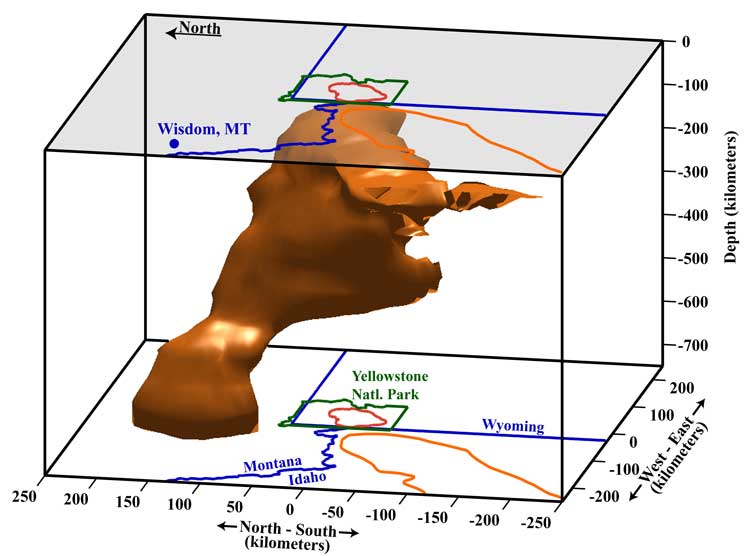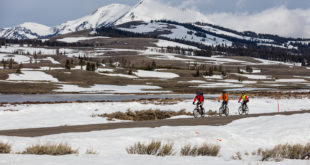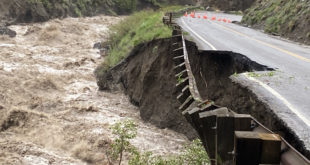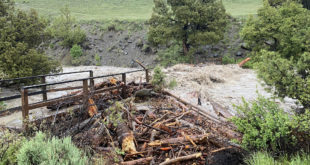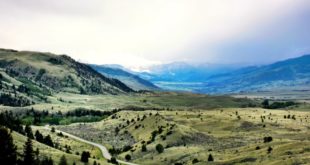The immediate cause was a build-up of molten lava beneath the Earth’s crust, creating a dome or bubble that eventually burst. But where did the lava come from? Some geologists believe it is from the motion of the Earth’s tectonic plates, the segments of the crust that are in constant (slow) motion. As the plates rub against each either, the heat of friction produces lava that then flows through fault-lines in the crust to produce eruptions. Other geologists believe that the type of volcanic activity seen in Yellowstone is the result of enormous plumes of very hot and lightweight lava rising from the Earth’s mantle, possibly even from the mantle-core boundary. These plumes rise high into the lithosphere (the crust) until they finally encounter rock equally ‘light’ near the surface. It is at this point that the volcanic domes are formed, until they finally become so pressurized that an eruption occurs.
The plume explanation has been favored by many geologists for Yellowstone’s eruption, but there has always been a weakness – the plume can’t be seen. Whatever a plume is, it occurs many miles below the surface in an area where observation or measurements of any kind have been extremely limited or non-existent. That is, until recently.
Over the last decade a massive seismology (earthquake) project has been mounted in the Yellowstone region, part of the Earthscope USArray, a coordinated effort across North America to measure earthquake activity with a dense grid of ultra-sensitive seismographs. The measurements taken by the seismographs spot the seismic waves created by tremors deep within the mantle. By combining the readings from many different locations a composite picture can be constructed in a technique known as seismic tomography. This is something like using tomography or MRI to scan the human body to construct an image of what is under the skin.
For the first time, data has been accumulating that allows scientists to build a picture (like a 3-D model) of activity occurring deep within the Earth underneath Yellowstone (about 372 miles deep). The first results were published during 2009 and continue with a series of studies, many from the University of California Berkeley Seismological Lab and the University of Utah Seismology and Active Tectonics Group.
The most recent paper, published in the journal Geophysical Research Letters August 10, 2010, by Mathias Obrebski (Berkeley) and colleagues, confirms earlier seismic studies identifying the Yellowstone plume. In addition the study makes a connection between the Yellowstone plume and the movement of tectonic plates.
In their new model, the Yellowstone plume rises from the mantle and encounters (in what is now Oregon) the relatively small and young Juan de Fuca tectonic plate as it slides under the North American plate between Washington, Oregon, and northern California. Because the Juan de Fuca plate is young and not yet hardened, the plume was able to break through — in effect cleaving the plate into segments. The paper suggests the breakup of the Juan de Fuca plate may have had profound effect on the rate of movement for all plates in the Pacific Northwest.
In any case, the rough shape of the Yellowstone plume and some of its characteristics have been described. While the plume remains fixed over a location in the mantle, the plates above continue to move, especially the North American plate, which slides to the southwest over the plume. This accounts for the chain of eruption sites and upwelling of lava from Oregon to Wyoming. The Yellowstone plume is at the moment not particularly hot, especially compared to plumes believed to underlie Iceland and Hawaii. This suggests that the Yellowstone super-volcano may miss its routine of erupting about every 600,000 years.
As far as humanity is concerned, that’s a good thing. The last eruption destroyed an area the size of Wyoming and spewed ash as far as the Caribbean – not to mention that it probably changed the climate and resulted in the die-off of many species. Even if the next Yellowstone eruption may never happen, or happen much later than expected, it’s a good idea to keep learning about the nature and effects of volcanic plumes. –Nelson King. Contributing editor King’s SciTectStory site tracks the impact of science and technology.
 Yellowstone Insider Your Complete Guide to America's First National Park
Yellowstone Insider Your Complete Guide to America's First National Park
